chapter 8
0.0(0)
Card Sorting
1/99
There's no tags or description
Looks like no tags are added yet.
Study Analytics
Name | Mastery | Learn | Test | Matching | Spaced |
|---|
No study sessions yet.
100 Terms
1
New cards
The ribs help protect which of the following?
lungs and heart
2
New cards
Which bones form the cranium?
Frontal, parietal, occipital, temporal, ethmoid, sphenoid
3
New cards
Choose all of the differences between male and female pelvises.
The male pelvis is more massive and rougher.
The female pelvis has larger pelvic inlet and outlet.
The female pelvis is wider and shallower.
The female pelvis has larger pelvic inlet and outlet.
The female pelvis is wider and shallower.
4
New cards
The sagittal, squamous, coronal, and lambdoid sutures border the_____bone.
parietal
5
New cards
The part of the maxilla called the_____process consists of points of bones that fill the spaces between the bases of teeth.
Alveolar
6
New cards
Choose the four prominent fontanels.
Anterior
Sphenoid
Posterior
Mastoid
Sphenoid
Posterior
Mastoid
7
New cards
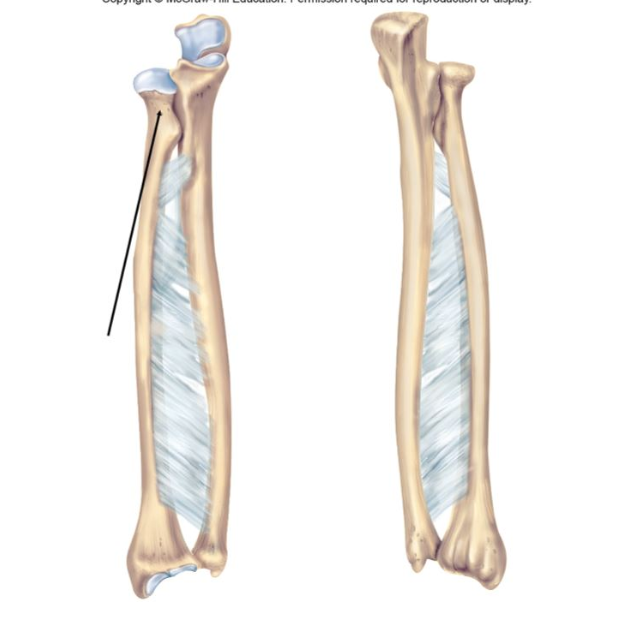
The structure indicated in the figure is the
neck of the radius
8
New cards
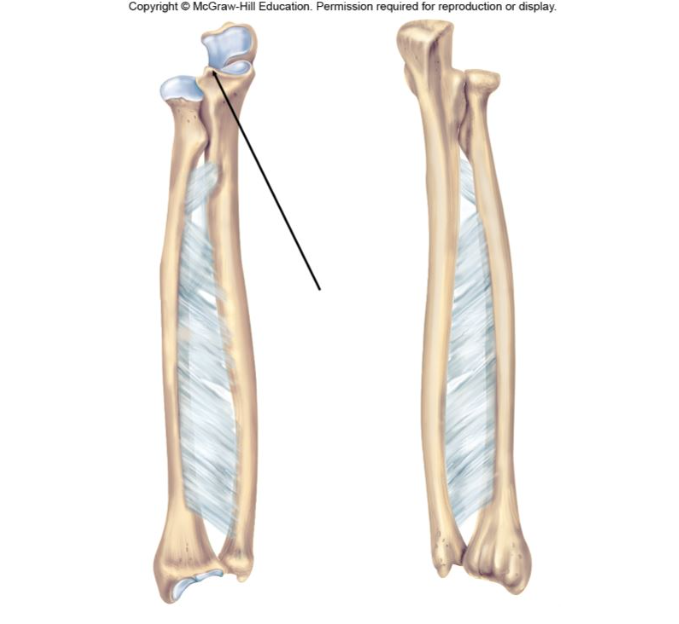
Which process of the ulna is indicated in the figure?
Coronoid process
9
New cards
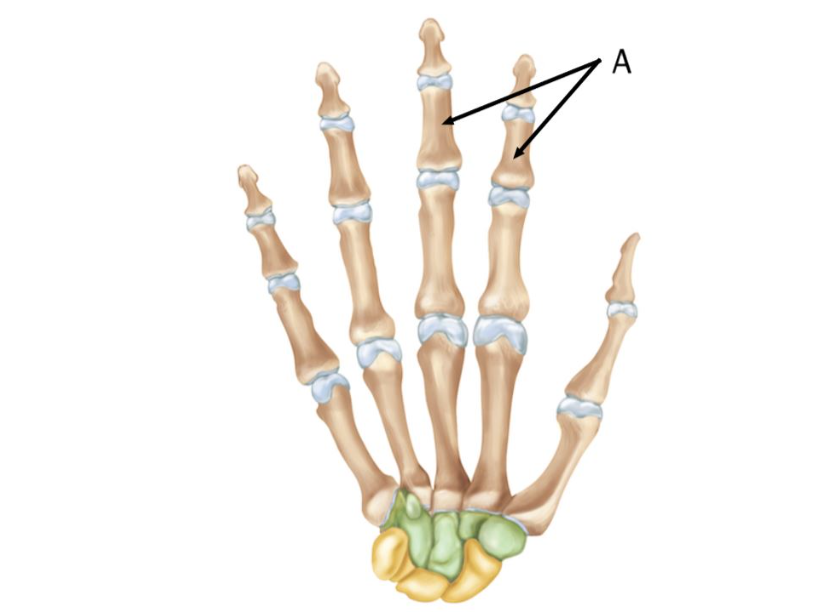
Which bones are indicated by the letter A on the figure?
phalanges
10
New cards
Match each anatomical bone marking with its correct description.
* condyle
* the prominet expanded end of a bone, somtimes rounded
* facet
* a rounded knob that articuates w/ another bone
* head
* a smooth, flat, articular surface
* condyle
* the prominet expanded end of a bone, somtimes rounded
* facet
* a rounded knob that articuates w/ another bone
* head
* a smooth, flat, articular surface
* Condyle
a rounded knob that articulates w/ another bone
* Facet
a smooth, flat, articular surface
* head
the prominent expanded end of a bone, sometimes rounded
a rounded knob that articulates w/ another bone
* Facet
a smooth, flat, articular surface
* head
the prominent expanded end of a bone, sometimes rounded
11
New cards
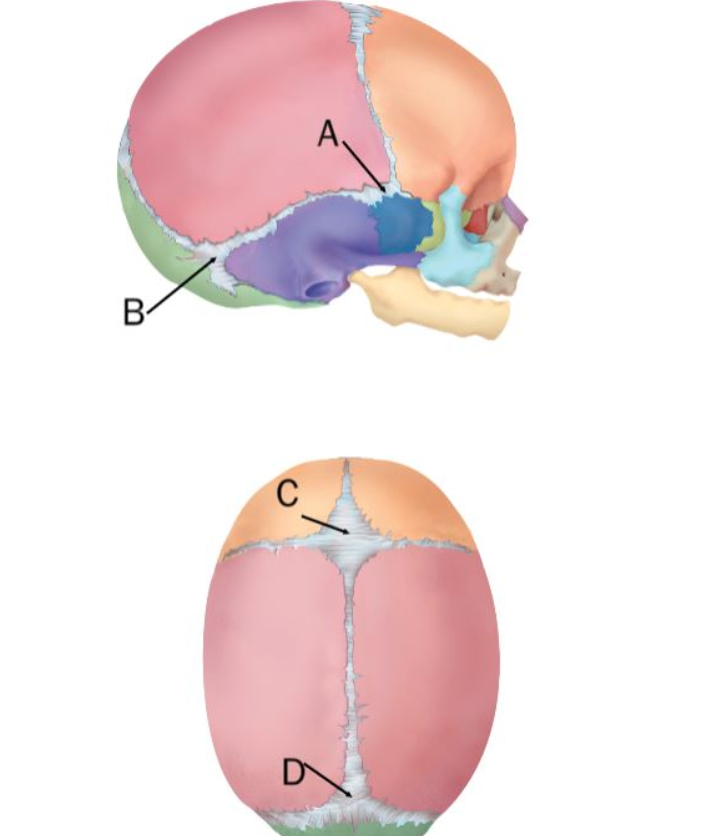
Identify the four prominent fontanels in the figure of the newborn skull.
* A
Sphenoid
* B
Mastoid
* C
Anterior
* D
Posterior
Sphenoid
* B
Mastoid
* C
Anterior
* D
Posterior
12
New cards
Match the segment of the upper limb with the number of bones it contains.
1, 2, 8, 5, 14
1, 2, 8, 5, 14
1 brachium
2 antebrachium
8 carpus
5 metacarpal
14 digits
2 antebrachium
8 carpus
5 metacarpal
14 digits
13
New cards
The suture between the parietal bones is the ______ suture.
sagittal
14
New cards
The processes of the maxillary bones that form the anterior 2/3 of the hard palate are called the
palatine processes
15
New cards
Which term refers to the spaces located between unfused cranial bones during early development?
fontanelles
16
New cards
Within the vertebral column, a(n)________ disc is a pad consisting of an inner gelantinous nucleus surrounded by a ring of fibrocartilage.
Intervertebral
17
New cards
The pectoral girdle includes which of the following bones?
Clavicle, scapula
18
New cards
Match the segment of the upper limb with its correct description.
Brachium
* contains the radius and ulna
Antebrachium
* contains the humers
Carpus
* contains the metacarpals and phalanges
Hand
* contains the wrist bones
Brachium
* contains the radius and ulna
Antebrachium
* contains the humers
Carpus
* contains the metacarpals and phalanges
Hand
* contains the wrist bones
* Brachium
Contains the humerus
* Antebrachium
Contains the radius and ulna
* Carpus
Contains the wrist bones
* Hand
Contains the metacarpals and phalanges
Contains the humerus
* Antebrachium
Contains the radius and ulna
* Carpus
Contains the wrist bones
* Hand
Contains the metacarpals and phalanges
19
New cards
The maxilla and palatine bones come together to form which of the following?
hard palate
20
New cards
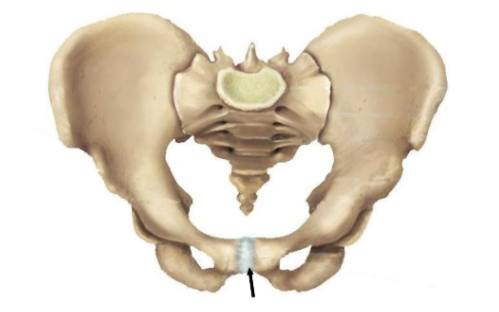
Identify the fibrocartilage structure indicated in the figure.
Interpubic disc
21
New cards
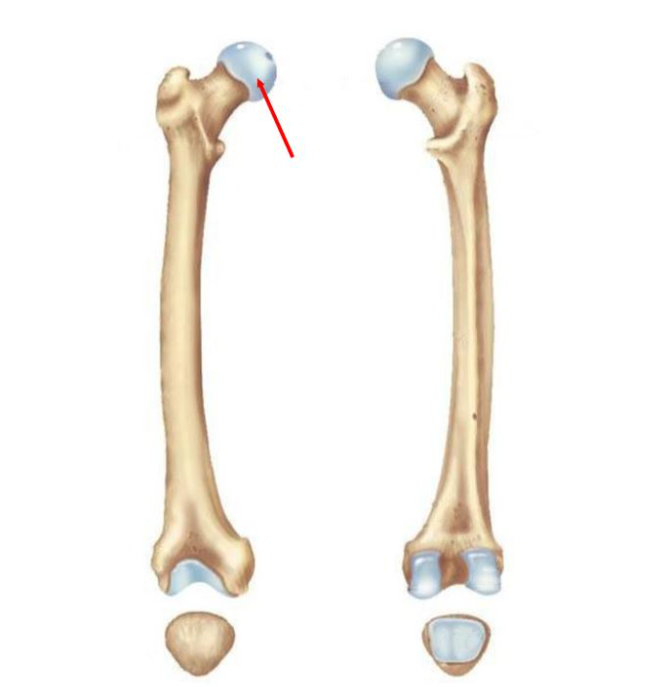
**Fill in the Blank Question**
The enlarged bony process indicated in the figure is the_____ of the femur.
The enlarged bony process indicated in the figure is the_____ of the femur.
head
22
New cards
Match the arch of the foot with the bones that make up the arch.
**Transverse arch**
Calcaneus, cuboid, and metatarsals IV and V
**Medial longitudinal**
Cuboid, cuneiform, and proximal heads of the metatarsals
**Lateral longitudinal**
Calcaneus, talus, navicular, cuneiforms, and metatarsals I to III
**Transverse arch**
Calcaneus, cuboid, and metatarsals IV and V
**Medial longitudinal**
Cuboid, cuneiform, and proximal heads of the metatarsals
**Lateral longitudinal**
Calcaneus, talus, navicular, cuneiforms, and metatarsals I to III
* **Transverse arch**
Cuboid, cuneiform, and proximal heads of the metatarsals
* **Medial longitudinal**
Calcaneus, talus, navicular, cuneiforms, and metatarsals I to III
* **Lateral longitudinal**
Calcaneus, cuboid, and metatarsals IV and V
Cuboid, cuneiform, and proximal heads of the metatarsals
* **Medial longitudinal**
Calcaneus, talus, navicular, cuneiforms, and metatarsals I to III
* **Lateral longitudinal**
Calcaneus, cuboid, and metatarsals IV and V
23
New cards
The purple arrow in the figure (also labeled A) represents which arch of the foot?
Medial longitudinal
24
New cards
The skull, vertebral column, and rib cage comprise the
axial skeleton
25
New cards
Which of following is a true statement and explains why the number of bones varies with age?
Many bones fuse together during development, resulting in fewer bones in the adult.
26
New cards
The cranial cavity encloses which of the following?
brain
27
New cards
Which of the following add resonance to the voice and lighten the anterior portion of the skull?
Paranasal sinuses
28
New cards
The largest cavity in the skull that encloses the brain is the
cranial cavity
29
New cards
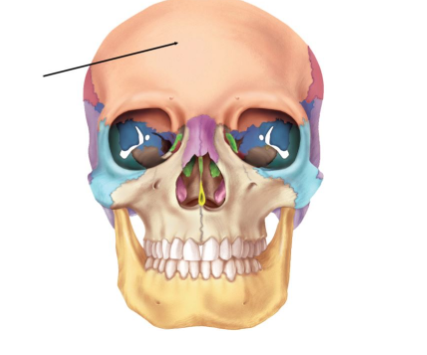
The cranial bone that is indicated by the arrow is the
frontal bone
30
New cards
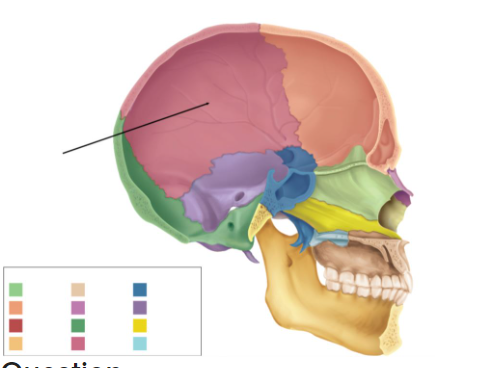
Which cranial bone is indicated in the figure?
Parietal bone
31
New cards
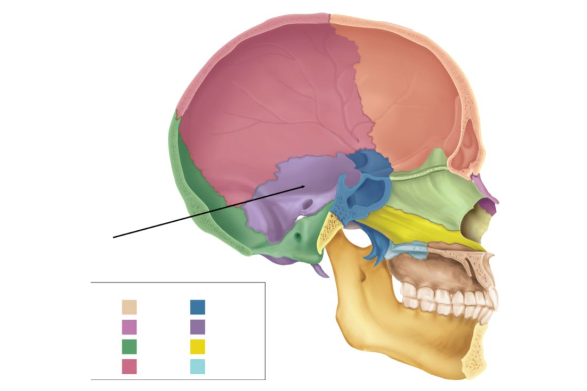
Name the skull bone indicated in the picture.
temporal bone
32
New cards
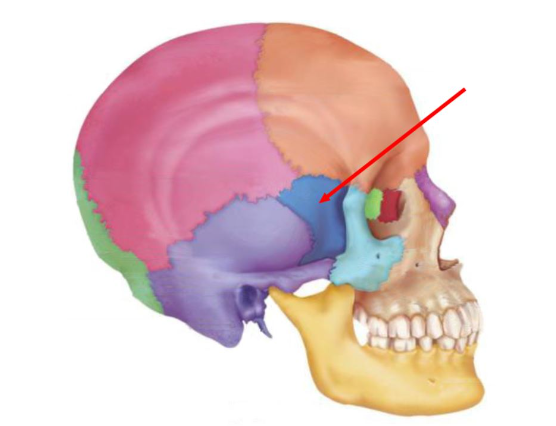
The bone indicated in the picture of the lateral skull is the______bone.
sphenoid
33
New cards
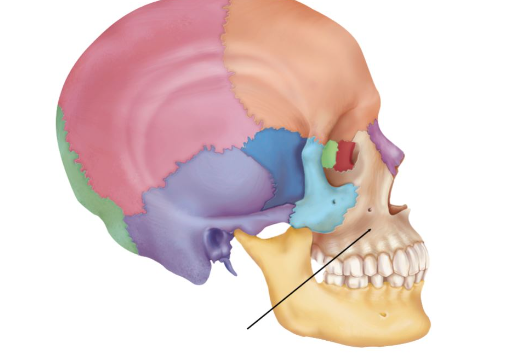
The facial bone indicated on the figure is the
Maxilla
34
New cards
The palatine bones forms part of the
hard palate
35
New cards
List the paranasal sinuses.
Ethmoid
Sphenoid
Frontal
Maxillary
Sphenoid
Frontal
Maxillary
36
New cards
The hyoid bone consists of a body, and two horn like projections called ______
greater and lesser horns
37
New cards
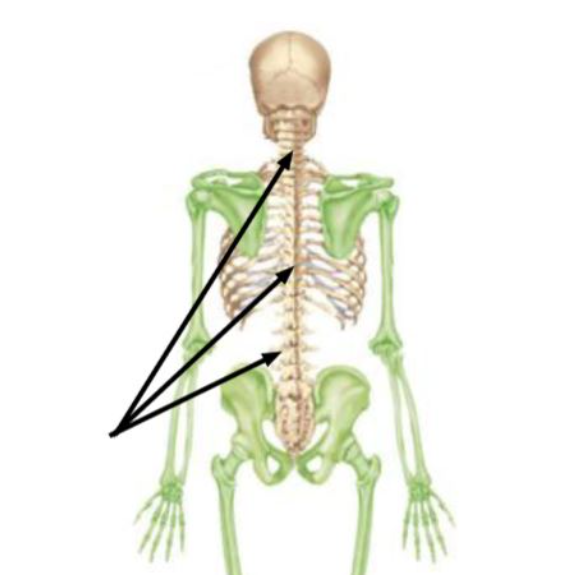
The entire region of the axial skeleton indicated by the arrows on the figure is the
vertebral or spinal **column**
38
New cards
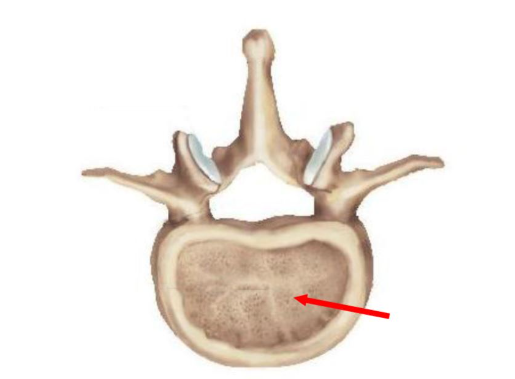
Identify the part of the vertebrae shown in the figure.
body
39
New cards

Identify the bone shown in the figure.
atlas
40
New cards
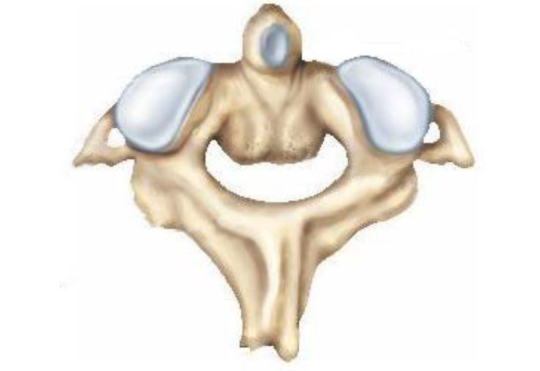
The specific vertebra shown in the figure is the
axis
41
New cards
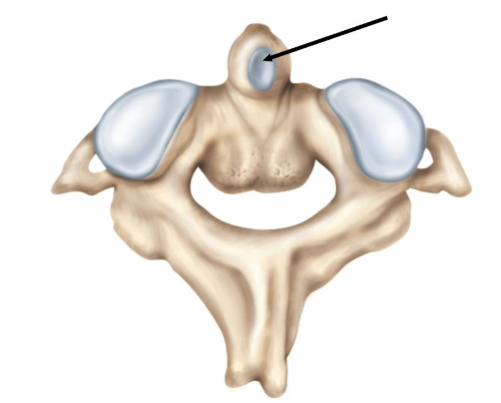
Identify the prominent bony process on the anterosuperior side of the axis indicated by the arrow in the figure.
dens
42
New cards
When are the sacral vertebrae fully fused?
Around 26 years of age
43
New cards
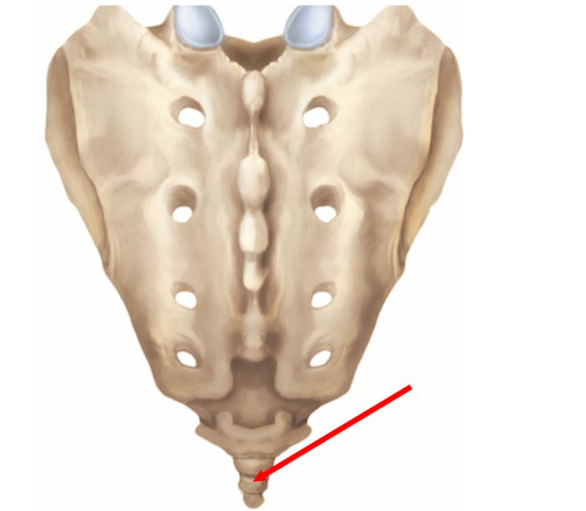
Identify the bone indicated by the arrow in the figure.
coccyx
44
New cards
The bone in the neck that does not articulate with any other bone is the_____bone.
hyoid
45
New cards
The joint between the sternum and the clavicle is the
sternoclavicular joint
46
New cards

The specific name of the vertebra shown in the figure is the
atlas C1
47
New cards
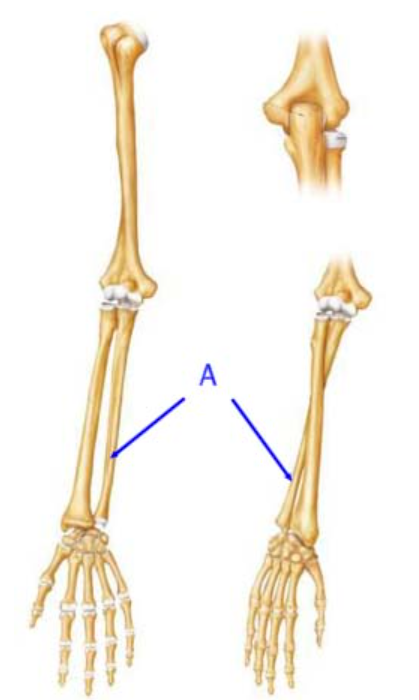
The bone indicated on the figure as "A" is the
ulna
48
New cards
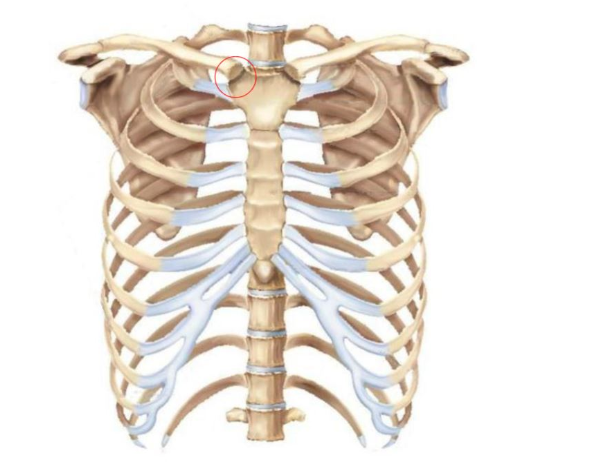
Which joint is indicated in the figure?
Sternoclavicular joint
49
New cards
The first cervical vertebra is called the
atlas
50
New cards
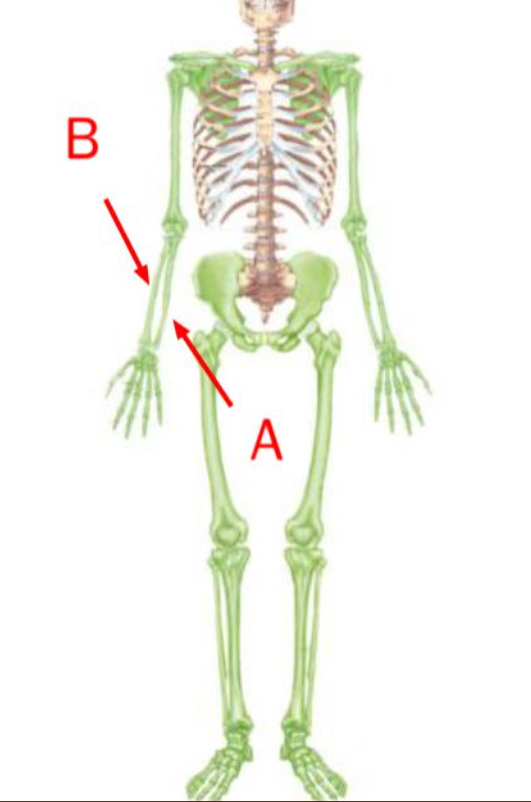
The bone indicated as "A" is the____ __. The bone indicated as "B" is the _______
“A” ulna
“B” radius
“B” radius
51
New cards
The group of bones that form the wrist are the
carpal
52
New cards
The hemispherical area of the humerus that articulates with glenoid cavity is the______of the humerus.
head
53
New cards
Which bone connects the sternum to the scapula and transfers force from the arm to the axial region of the body?
Clavicle
54
New cards
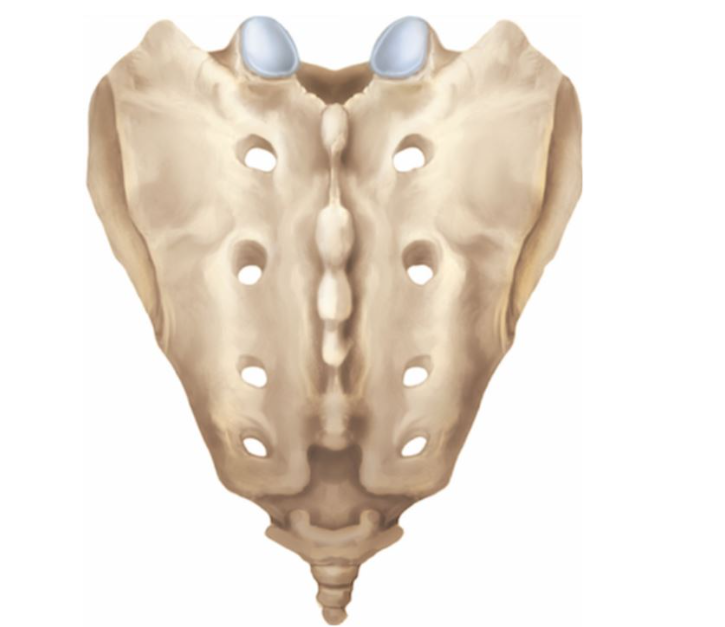
Name the bone of the axial skeleton pictured here.
Sacrum
55
New cards
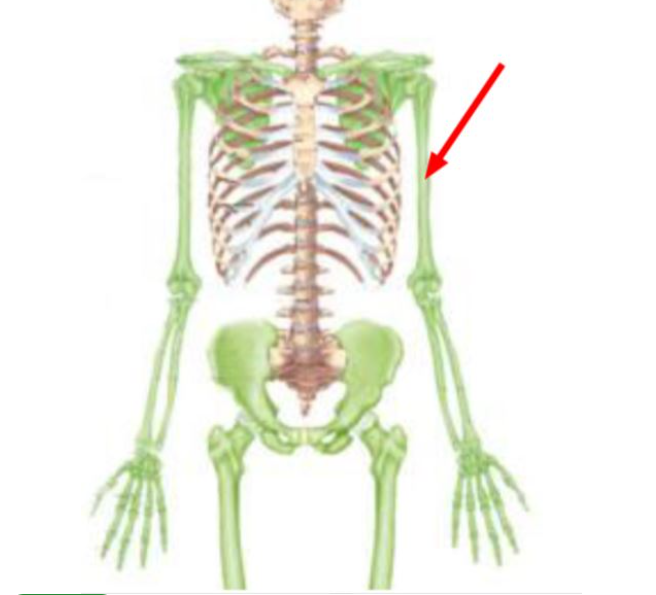
the_____is the bone indicated by the red arrow in the figure.
humerus
56
New cards
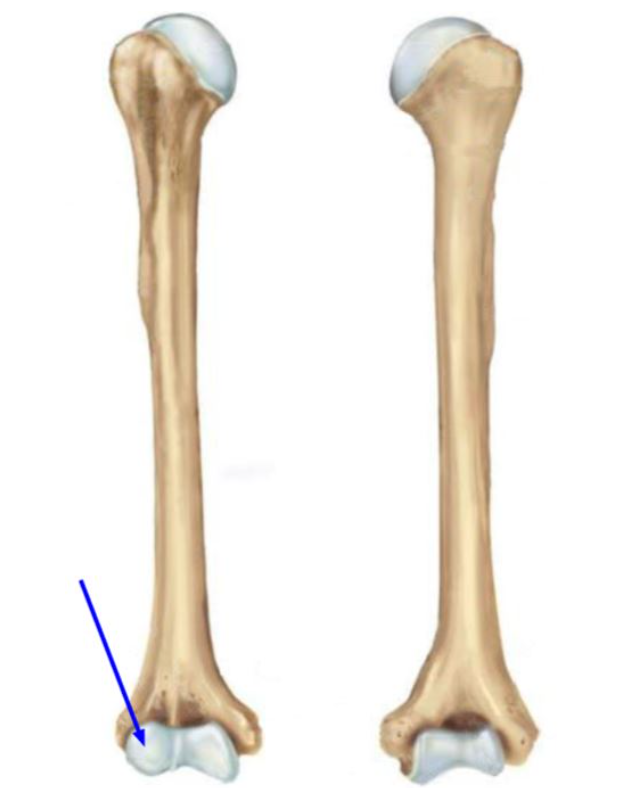
The rounded lateral condyle indicated in the figure is the
capitulum
57
New cards
Name the small processes on the humerus that are located proximal to the trochlea and capitulum.
Epicondyles
58
New cards
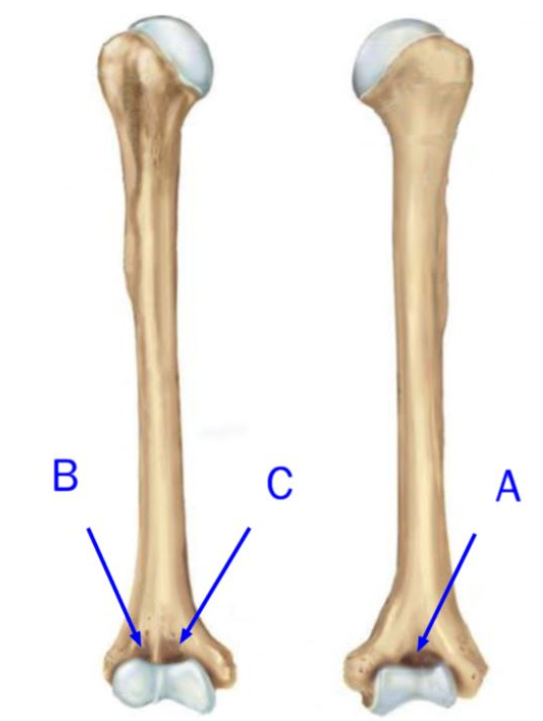
Match each fossa of the humerus with the letter that properly identifies it on the figure.
* A
Olecranon fossa
* B
Radial fossa
* C
Coronoid fossa
Olecranon fossa
* B
Radial fossa
* C
Coronoid fossa
59
New cards
Which is the lateral bone of the forearm?
radius
60
New cards
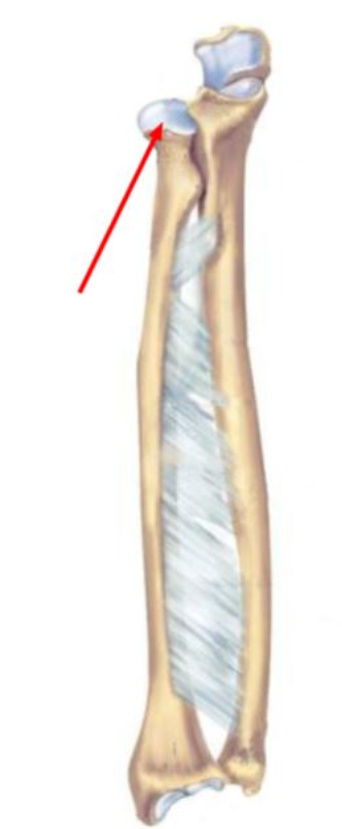
Identify the structure indicated in the figure.
Head of the radius
61
New cards
Which notch at the proximal end of the ulna accommodates the head of the radius?
Radial
62
New cards
The carpal bones form which of the following?
Wrist
63
New cards
Which of the following lists the parts of a metacarpal from proximal to distal?
Base, body, head
64
New cards
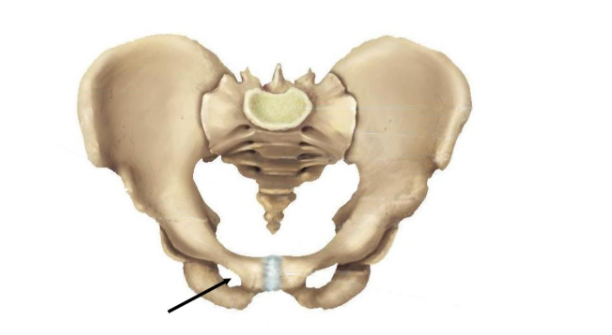
The opening indicated in the figure is the
obturator foramen
65
New cards
Which three bones make up the hip?
Ilium
Pubic
Ischium
Pubic
Ischium
66
New cards
Match the segment of the lower limb with its correct description.
Femoral region
* Contains the tibia and fibula
Crural region
* Where the crural region and foot meet
Tarsal region
* Contains the tarsals, metatarsals, and phalanges
Foot region
* contains the femur
Femoral region
* Contains the tibia and fibula
Crural region
* Where the crural region and foot meet
Tarsal region
* Contains the tarsals, metatarsals, and phalanges
Foot region
* contains the femur
* Femoral region
Contains the femur
* Crural region
Contains the tibia and fibula
* Tarsal region
Where the crural region and foot meet
* Foot region
Contains the tarsals, metatarsals, and phalanges
Contains the femur
* Crural region
Contains the tibia and fibula
* Tarsal region
Where the crural region and foot meet
* Foot region
Contains the tarsals, metatarsals, and phalanges
67
New cards
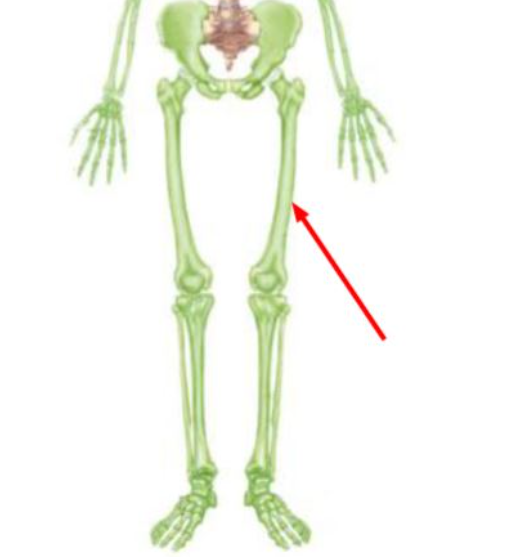
Name the bone indicated on the figure.
femur
68
New cards

The indented region indicated in the figure is the
neck of the femur
69
New cards
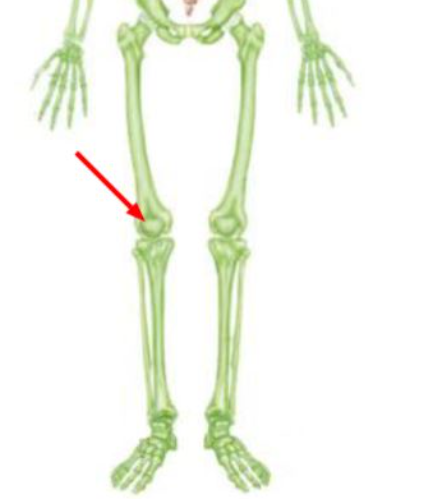
The bone indicated on the figure is the
patella
70
New cards
Which bone is the only weight-bearing bone of the crural region?
tibia
71
New cards
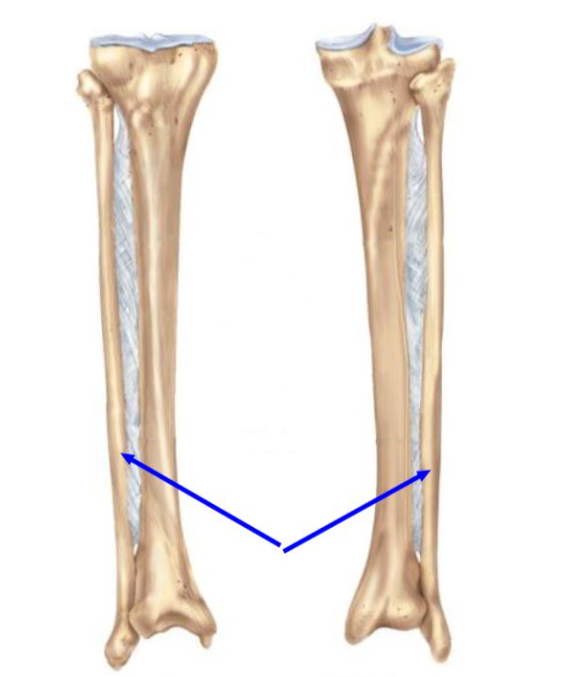
Name the bone indicated by the blue arrow in the figure.
fibula
72
New cards
Which of the following is a slender leg bone that functions to stabilize the ankle but does not bear any weight of the body?
Fibula
73
New cards
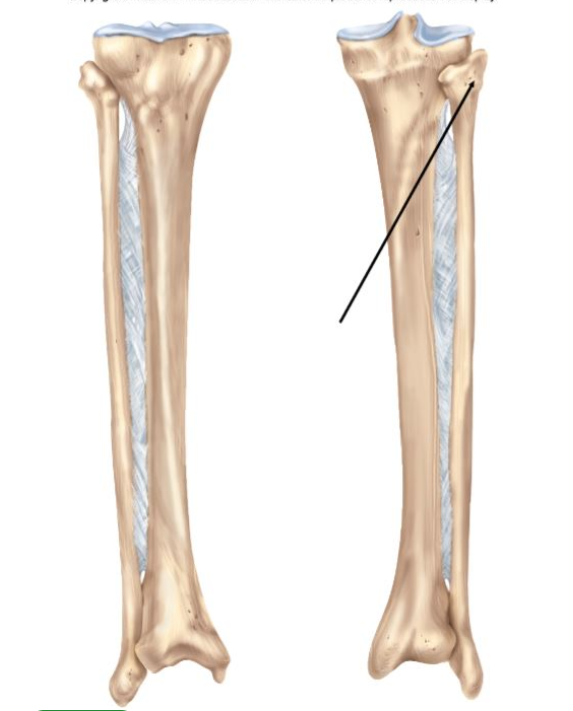
The process indicated in the figure is the
head of the fibula
74
New cards
What is the correct system for naming the metatarsals?
The metatarsals are named with Roman numerals I through V from medial to lateral.
75
New cards
Identify the three angles of the scapula.
Inferior
Superior
Lateral
Superior
Lateral
76
New cards
The skullcap that forms the roof and walls of the skull is called which of the following?
Calvaria
77
New cards
Match the segment of the lower limb with its correct synonym.
* Thigh
Crural region
* Leg
Pedal region
* Foot
Femoral region
* Thigh
Crural region
* Leg
Pedal region
* Foot
Femoral region
* high
Femoral region
* Leg
Crural region
* Foot
Pedal region
Femoral region
* Leg
Crural region
* Foot
Pedal region
78
New cards

Name the series of bones indicated on the figure of the foot.
Metatarsals
79
New cards
The average number of bones in the adult skeleton is
206
80
New cards
All the bones below belong to the axial skeleton, except the __________, which belongs to the appendicular skeleton.
scapula
81
New cards
Why does an adult not have as many bones as a child?
Some separate bones gradually fuse with age.
82
New cards
What is a sesamoid bone?
A bone that forms within some tendons in response to stress
83
New cards
A hole *through* a bone that usually allows passage for nerves and blood vessels is called a(n)
foramen
84
New cards
Most of the bones of the skull are connected by immovable joints called __________.
sutures
85
New cards
The __________ suture separates the temporal bone from the parietal bone.
squamous
86
New cards
Fontanelle are __________ in an infant.
spaces between the unfused cranial bones
87
New cards
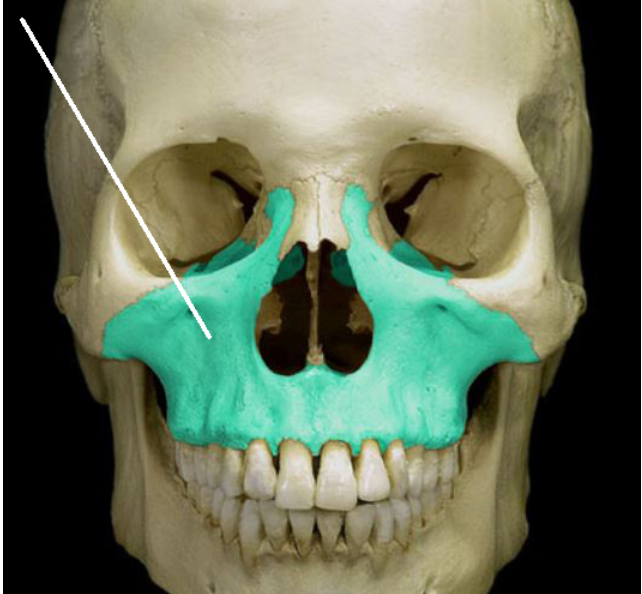
Identify the bone highlighted in green
Maxilla
88
New cards
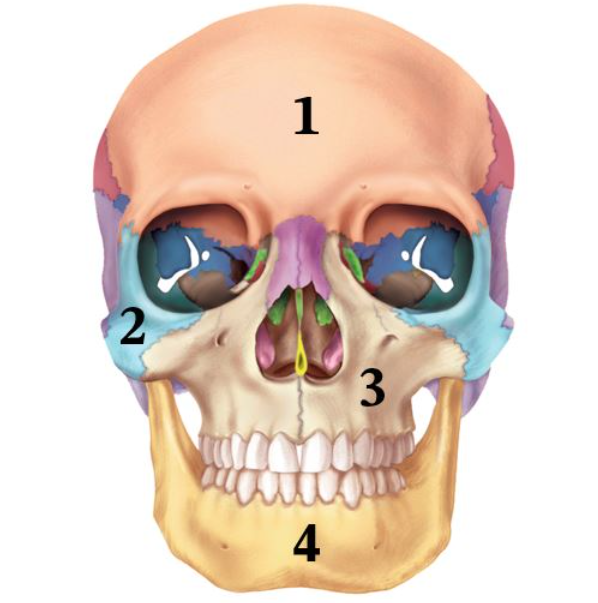
Name the bone labeled 1.
Frontal bone
89
New cards
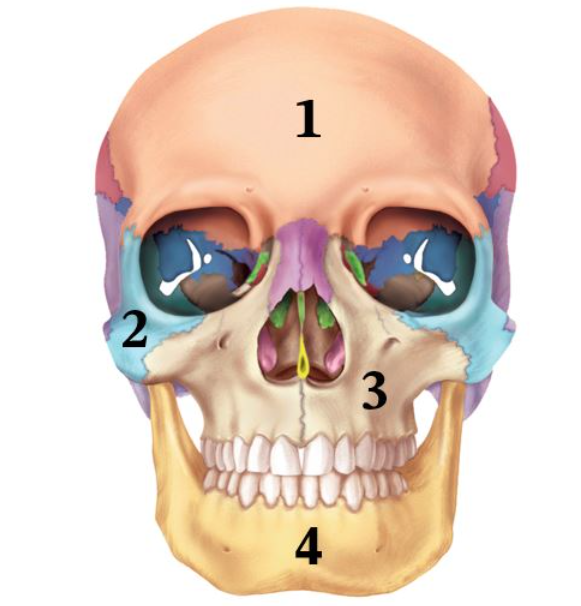
Name the bone labeled 4.
Mandible
90
New cards
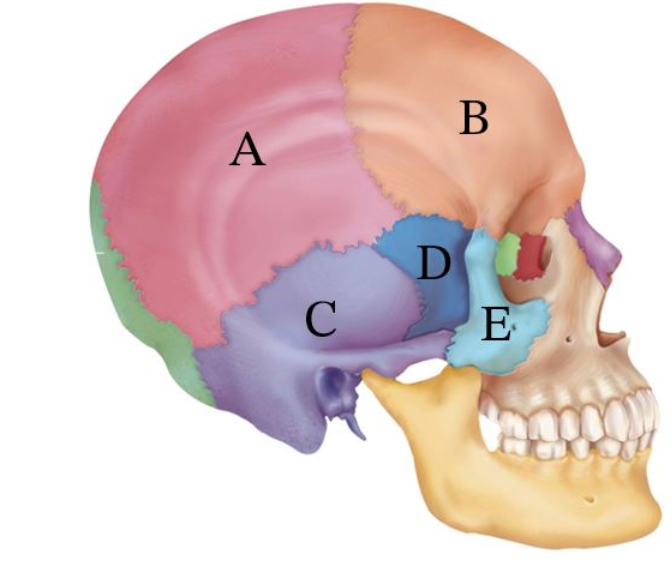
Which letter corresponds to the temporal bone?
C
91
New cards
Rib 7 is a __________ rib.
true
92
New cards
From superior to inferior, how many individual vertebrae are there of each type?
7; 12; 5; 5; 4
93
New cards
Which of the following is only found on the axis vertebra?
Dens (odontoid process)
94
New cards
95
New cards
96
New cards
97
New cards
98
New cards
99
New cards
100
New cards